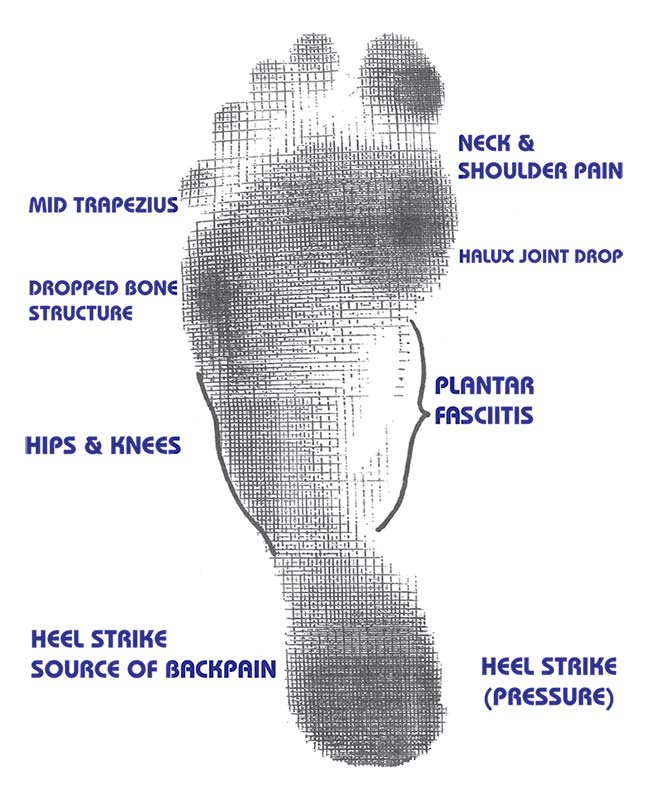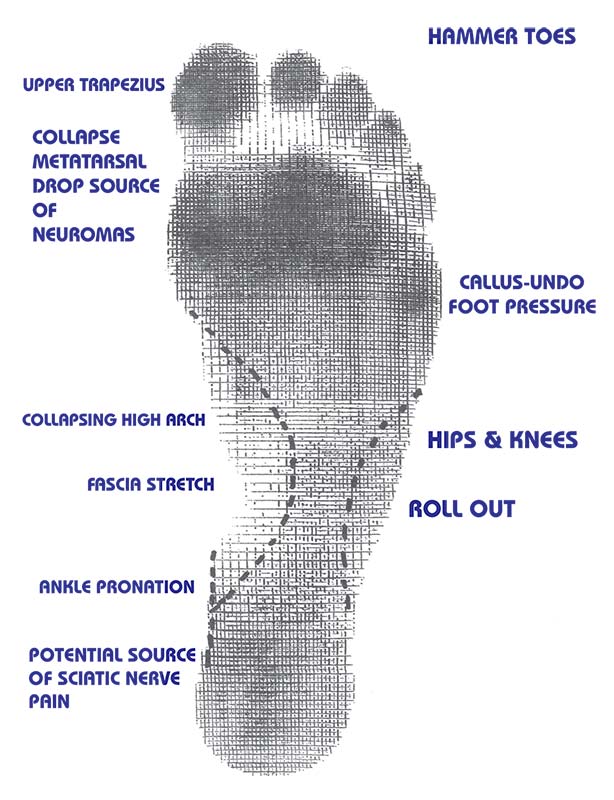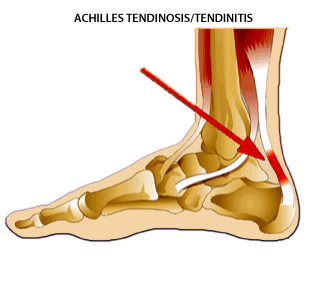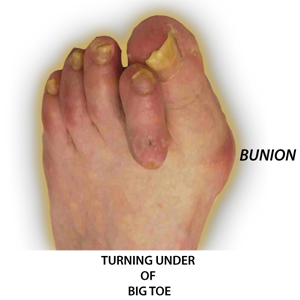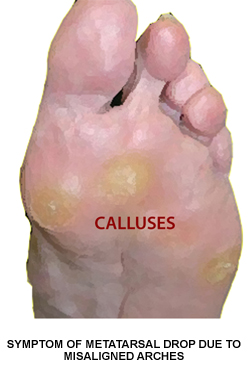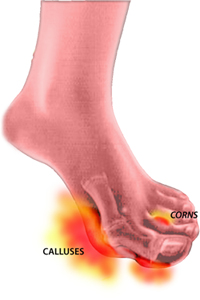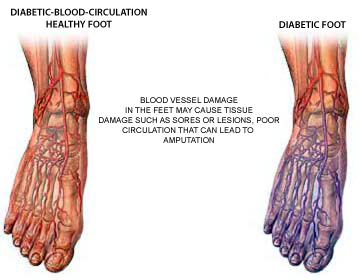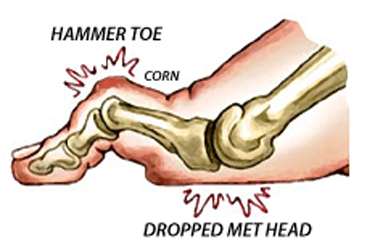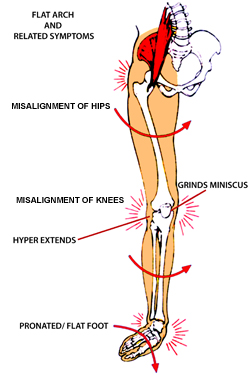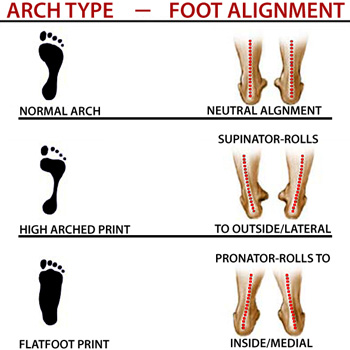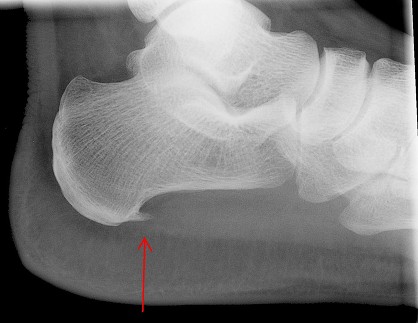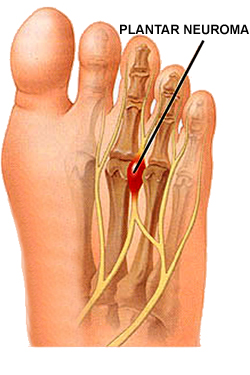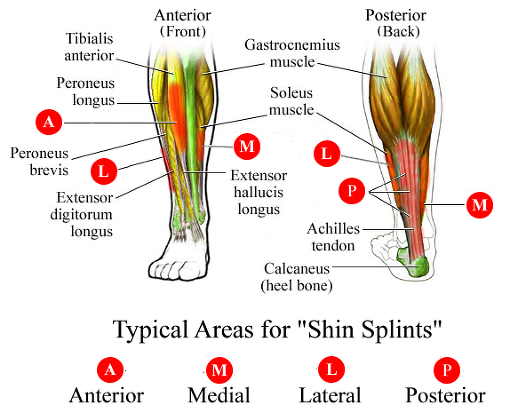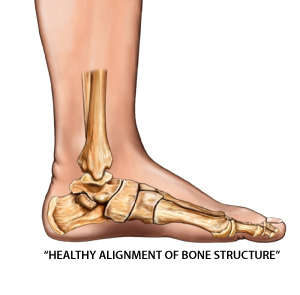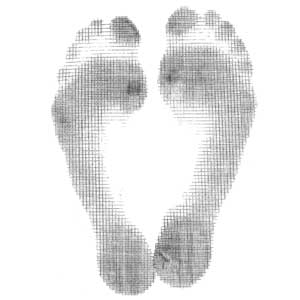Common Foot Problems
Achilles Tendonitis
Indications include pain anywhere along the back of the tendon, but usually near the heel. It may cause redness or heat over the painful area. One of the causes of Achilles pain is misalignment of the arches, causing supination or pronation. The heel may arch sideways stretching the tendon.
Using the Forward Arch® Corrective Orthotic or Tri-Support will help stabilize the bone structure of the foot, relieving the pressure of pulling the ligaments and tendons. This alignment also helps the lower back, hip, knee and lower leg.
Bunions
Most bunions are behind the point of the large toe on the large metatarsal bone. “Bunionettes” are behind the little toe (the outside of the foot). Misaligned arches are usually the cause of bunions, pronation or supination.
Excessive pressure in the joint area will build up fluid and tissue inflammation in the bursa sac. The joint will build up calcium deposit in the area. Wearing high heels and shoes with tight toe boxes will exacerbate the problem.
Bunions can be triggered by pronation of the heel.
Using the Forward Arch® products will help re-align the foot by supporting the three arches and taking pressure off the ball of the foot.
Wearing shoes that have room in the foot bed will help to relieve pressure or rubbing in the area.
Calluses
Thickening of the skin, usually located on the bottom of the foot. Misalignment of the arches can cause friction or rubbing against the skin causing the hardness of the skin and the accumulation of dead skin. Calluses on the ball of the foot are due to metatarsal heads collapsing. Also, skin around the heel area can become thick and start to crack.
Wearing the Forward Arch® orthotic will support the bone structure of the ball of the foot and take pressure off the heel. By taking your weight off your bone structure and placing the foot over a proper support, our orthotic will help build up the muscle structures and help place the bone structure back into alignment. Over time, the calluses will be greatly relieved or go away.
Corns
These are also caused by misalignment, which causes friction on top of the toes. They may be a symptom of hammertoes.
Tight fitting shoes and misalignment of the foot structure are causes of corns.
Wearing our Forward Arch® products will help your toes straighten out and become free and floating.
Diabetes
This is a major cause of poor circulation and peripheral neuropathy in the body’s extremities. Problems caused by the diabetic foot are the most common reason for hospitalization and amputation in the lower leg, foot and toes.
Wearing our Forward Arch® products helps to increase circulation and help increase balance issues. Our products are made from non-absorbent materials. Not all products on the market can make that claim. This is why we can offer a lifetime guarantee against breaking or cracking.
Dropped Metatarsals
Metatarsals are the bones in the ball of the foot. We use these bones to push off when we walk as well as the toes.
A dropped metatarsal is caused by the misalignment of the arches and the bone structure can no longer support itself and the bone structure collapses. Wearing the Forward Arch® orthotic will help relieve pressure off the bone structure and help build up the muscle structure of the foot allowing the dropped metatarsal head or heads to be supported.
Flat Feet/Fallen Arches/Pronation
We are all born with flat feet or muscle pad. Usually between the ages of five or seven, our arches start to develop or not.
Pronation is the process by which you shift your weight from the outside of your foot to the inside. As your heel hits the ground, your foot has a rolling in motion, thereby flattening out your foot. This rolling in, pronation, may also effect your sciatic nerve.
Wearing the Forward Arch® Corrective Orthotic over time can help strengthen the muscle structure and help build the arch back into your feet. Remember, arches are muscle.
A pronated foot can also effect ankles, knees and hips.
High Arch/Supination
This is the process by which you shift your weight to the outside of your foot. Your arches can be so high that you are only walking on your bone structure, heel, ball and toes; all pressure areas.
Stability and shock absorption can be a problem. Neutralizing the foot by wearing the Forward Arch® Corrective Orthotic can help bring down the high arched foot. Depending on the severity of the arch, two or three increases in the orthotic length may be called for. This is why we offer a six-month free exchange warranty. As the foot neutralizes, the metatarsal arch in the orthotic can move back towards the heel. Symptoms may reappear and the orthotic will press up into the bone structure in the middle of the foot, taking it out of the metatarsal arch of the foot.
Heal Spurs
Accumulation of calcium in the heel area is caused by the tearing of the fascia from the heel (Plantar Fasciitis). The body can send calcium to the area of the tear to work like glue to help prevent more tearing. The heel spur doesn’t usually hurt. The discomfort or pain is caused by the inflammation of the microscopic tearing. This can come and go and last for years. Sometimes a small hook shape can be on the top of the spur.
Wearing the Forward Arch® Corrective Orthotic will support the heel and allow the soft tissue to heal.
Plantar Fasciitis
Heel pain usually caused by inflammation, tearing of a long band of connective tissue running from the heel to the ball of the foot.
Plantar Fasciitis is caused by misaligned arches. Pronation or supination can cause pulling or stretching of the ligaments.
Due to walking on hard surfaces over the years, our muscle structure weakens, the bone structure collapses, and ligaments and tendons can dry up due to decreased blood flow. Wearing the Forward Arch® Orthotic can help you build up the muscle structure and increase circulation, thereby sending an increase of red blood cells, oxygen and nutrients to the area of the tear. By supporting the bone structure, pressure is relieved from the heel.
By attacking the cause of Plantar Fasciitis, the use of painkillers, cortisone (which is a steroid), and surgery may be alleviated.
Plantar Neuromas
Irritated, inflamed nerves in the ball of the foot, most commonly between the third and fourth toes.
The nerves between the toes get pinched and tissue develops around the nerve.
Freeing up the toes by wearing the Forward Arch® Corrective Orthotic will take the pressure off the pinched nerve.
Many runners and skaters develop neuromas due to heavy forefoot pressure. Be sure your shoes have plenty of the room.

